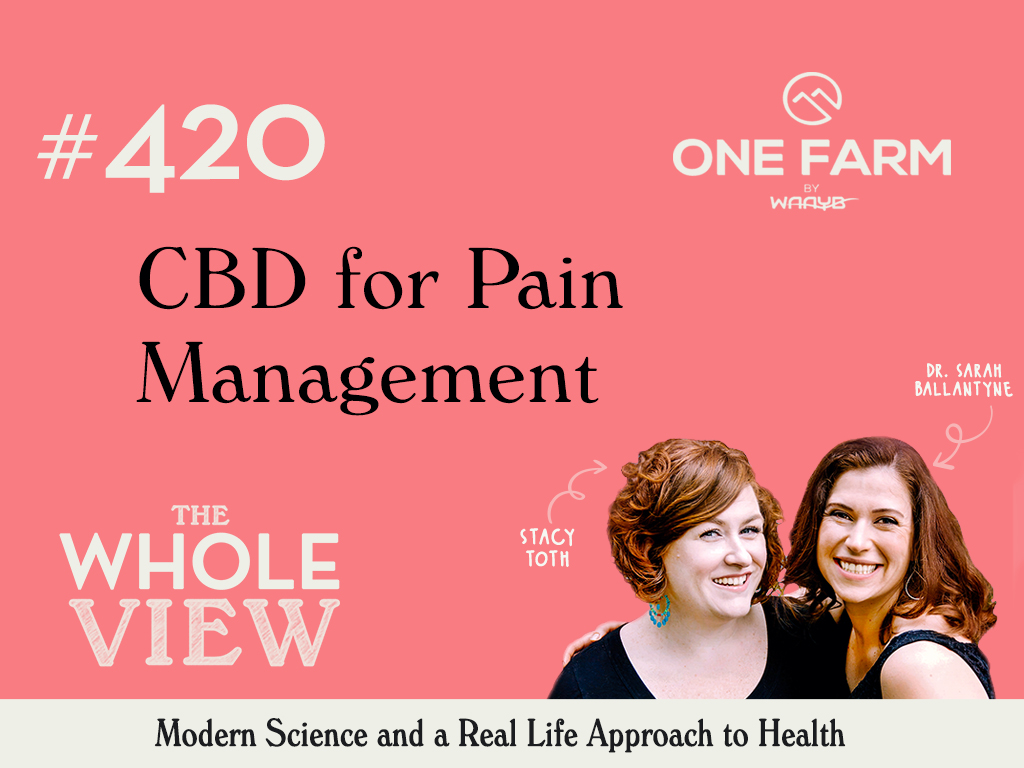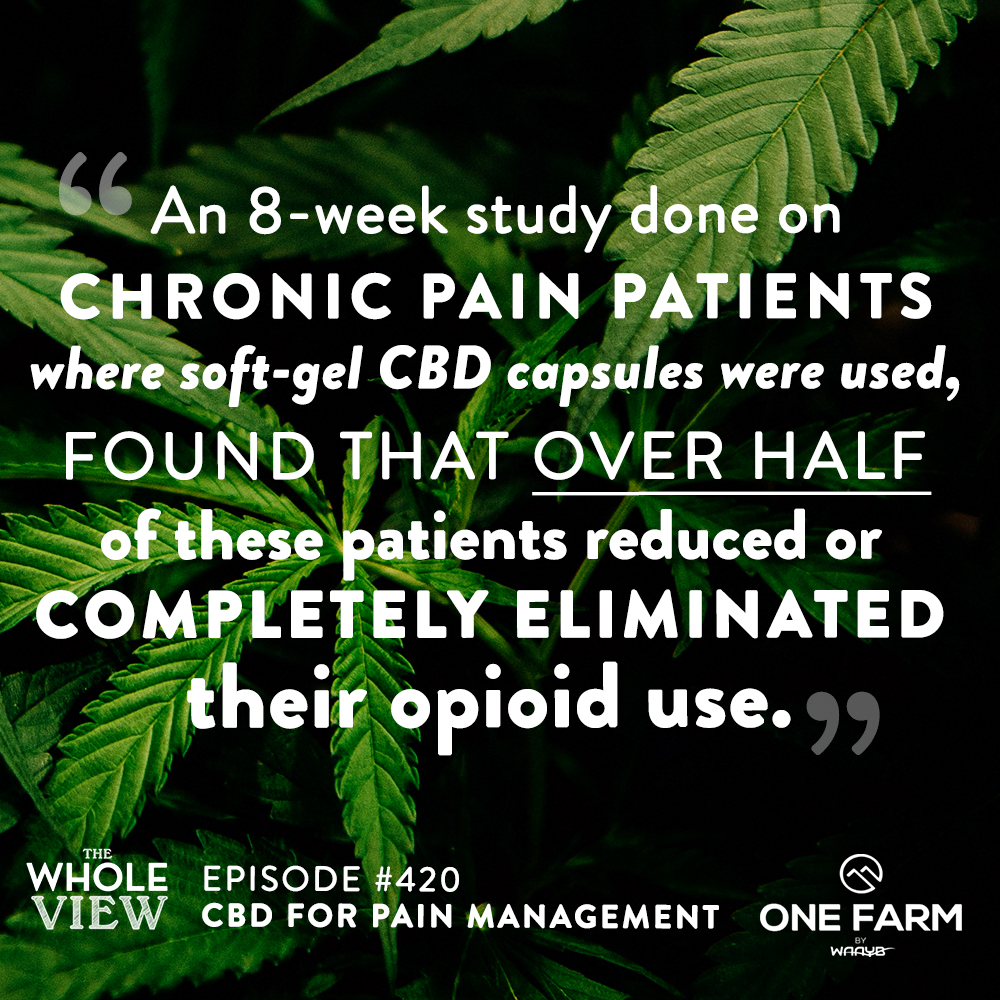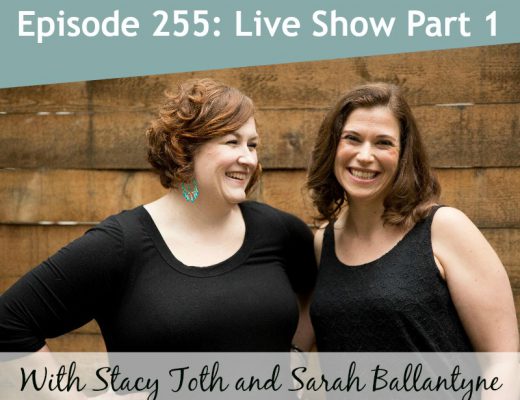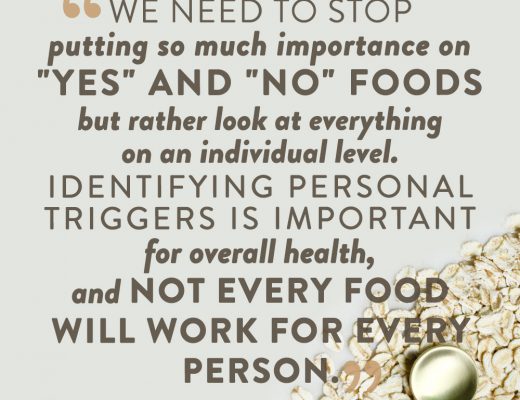
Welcome to episode 420 of The Whole View. This week Stacy and Sarah discuss the use of CBD for pain management. Stacy and Sarah both share their personal experiences with using CBD, and Sarah breaks down the science on why this has been such a helpful tool in many ways. Tune in below!
If you enjoy the show, please review it on iTunes!
The Whole View, Episode 420: CBD for Pain Management
Welcome back to the Whole View, wait for it – 420. (0:27)
And this week we are talking about CBD, for episode 420.
All jokes aside, we did have a CBD episode at the beginning of March for episode 393.
CBD was something that Stacy had to avoid while working full-time, which is crazy because if you are using a high-quality brand there is 0% THC.
However, Stacy has a security clearance that she didn’t want to jeopardize.
She had read about it being good for pain management and reducing inflammation, but as of the last episode hadn’t tried using CBD for that.
Recently, Stacy had a flair when they were camping and was able to avoid muscle relaxers, heavy-hitting medications, and being completely down for a week, which is what typically happens.
Once Stacy got the initial inflammation down through a few key strategies, the CBD was able to quickly regulate it.
She was able to get her physical therapy in the pool to continue the healing process and had no other issues.
It was crazy!
So today we are going to talk more about Stacy’s pain management, and how she got to know what she needed to do to manage it.
Also, how she has been able to add in more strenuous exercise more recently, which she does attribute to adding CBD into her routine.
Sarah has science on the mechanisms for that, which she will explain more.
If you have pain, keep an open mind and find a way to at least try it.
Our Favorite Source
We are partnering with One Farm, the brand that we love for tested, organic, and US-made hemp extract. (3:55)
Because if you are going to try it, we want you to use a brand that will be effective and that is giving you the benefits of CBD that Sarah is going to talk about.
You want to make sure that you use a brand that is tested and safe for you.
This is why we asked One Farm to partner with us, and they are sharing a 15% off code with our listeners.
Stacy recommends a topical CBD treatment as well as consumed, in addition to applying a topical lotion that has the benefits of CBD.
One Farm has an awesome Tumeric lotion, with CBD as the main active ingredient, that Stacy really loves – and it has no orange color to it, don’t worry.
Use the code WHOLEVIEW to get 15% off your order using this website link.
If you want to know more about the basics of CBD and more about this brand, be sure to also reference our podcast episode 393.
Sarah has been using One Farm for a long time and they check all the boxes for her.
What inspired her to try CBD was a bunch of questions she received in a session regarding pain management.
At the time she hadn’t dug into the science in-depth, but the interest in this topic sparked Sarah to dig deep into the research.
The research essentially talked Sarah into trying it, and she chose One Farm because they are US based, USDA organic, and they do all the right things to ensure the highest quality.
Sarah briefly explained the difference between THC and CBD.
Fibromyalgia pain is really what brought Sarah to incorporate CBD, but she found that it was also so beneficial for her sleep and anxiety.
Stacy’s Experience
Very similarily to Sarah, Stacy started with just using it occasionally for when she felt like she needed it. (12:12)
She focused on using it for anxiety, as Stacy didn’t think it would help with pain management.
Truthfully, in the beginning, Stacy felt very skeptical of using CBD.
However, after recording episode 393, Stacy realized that it might be more beneficial to begin using it on a regular basis.
Stacy is going to share her personal experience and share the specifics of her regimen.
But please remember, we are not medical professionals.
CBD is a supplement and is not tested or approved as a drug by the FDA, while One Farm is unique in it’s USDA organic farming certification.
For a bit of background, Stacy was a competitive lifter and she was Northern Virginia’s Strongest Woman.
She competed in the sport of Strongman.
Stacy was working in the garden and took on an in-the-moment physical challenge, which led to a lower back injury.
She went through a whole bunch of doctors and physical therapy for years.
However, it essentially got to the point when the doctor said there was nothing they could do unless Stacy wanted to have surgery.
Surgery would have only led to an 80% recovery, and Stacy was told that she would not be able to lift heavy weights again.
Over the last couple of years, Stacy has been able to get herself to 95%, where she very rarely has a flair and doesn’t experience consistent pain like she use to.
Water aerobics and red-light therapy brought some good results, which allowed Stacy to start riding her Peloton bike.
It was also around that time that she begin taking CBD every day.
She doesn’t have any pain, all the time, anymore – which is a big deal for Stacy.
Then vs. Now
When Stacy does have a flair it is not as severe as they use to be. (16:45)
A flair use to take Stacy out from work for ten days, she had to get a really heavy prescription and do nothing but lay on her side.
Now she had a flair while she was camping, and the severe part of it lasted four hours until she could take an NSAID.
After one dose of an NSAID, and taking her CBD products, she was able to get into the pool.
From there all she took was CBD.
She was already doing lifestyle factors, consuming low-inflammatory foods, and optimizing her sleep, yet a back flair use to lay her up for over a week and require the use of heavy pain medications to mitigate the pain and inflammation.
Now she is perfectly fine after a few steps and just needs to take the CBD for a few days to keep the inflammation down.
This to her has the potential to change lives.
To know that she has this option changes Stacy’s life.
She knowns that can do strenuous family activities, or go on that hike, and even if she tweaks her back she will be ok.
The one thing that she wants to say is that CBD has allowed biking into her life.
When the quarantine began and she could no longer do water aerobics she was crushed.
Not getting her alone time and physical exercise was very hard on her well-being, both physically and mentally.
She got the bike “for the boys” because she was afraid to say she wanted it for herself in case it hurt her back to ride.
Stacy knows that she would have never been able to do that strenuous exercise without this reduction in inflammation.
Being able to take herself to no-pain on the regular, means that if she rides the bike and goes hard it brings her nothing but the positive benefits.
There is no way Stacy could have pushed herself like this before.
Stacy still needs to take care of herself by moderating that her food is optimal for low-inflammation.
If she doesn’t take her CBD to keep the inflammation down, it escalates as she sleeps, and when she wakes up the next morning the pain will be at an 8 or 9.
She shares this to show how she reached this point and all the little things that contribute to this big difference.
However, she also knows that there is something very special to the CBD aspect, which Sarah was able to confirm.
Listeners, if you or someone you know is experiencing chronic pain, whatever they need to do to make trying this work – help them.
Stacy was in a place where she had given up, but her quality of life has changed so dramatically since incorporating CBD.
She wants people to know that getting rid of chronic pain is possible.
This is exactly why Sarah wanted to talk about this on the podcast.
The Way it Works in the Body
There is an association with pain killers and being high. (24:24)
So it is a natural skepticism of a pain relief product.
If you are taking a product that is high in CBD but doesn’t have TCH, how can it work as a pain relief product?
It doesn’t seem like the normal things that we go to for pain without the psychedelic component.
This is why Sarah thinks it is so cool to look at the science because there is actually a lot of it.
To give a brief recap of everything we covered in episode 393, the endocannabinoid system is a system in the human body that is basically the interface between the sensation of pain, the emotional response to that pain, and the physiological response to the pain.
Pain is often caused by an injury, and the body needs to be able to ramp up the immune response in order to heal whatever damage there is.
The context of pain changes how the emotional response is.
It is the endocannabinoid system that is linking all of these things together and puts context to pain.
This system activates the immune response in response to ‘I felt pain’.
It is also the system that is responsible for the maladaptation to chronic pain.
Chronic pain comes with mental health challenges and a highly ramped up emotional response.
Cannabinoids, in a variety of situations, has very powerful anti-inflammatory effects, and are both primary and secondary influences on pain.
This means that it influences the primary perception of pain, and the secondary influence on pain is everything downstream from that.
It has been shown to be beneficial in terms of immune regulation, the healing response, mental health, the emotional response to pain, as well as the physical sensation of pain.
Separating THC to Understand CBD
So it has been studied for years and there is a huge wealth of scientific studies. (30:01)
The early studies looked at cannabis as a whole, so a lot of it was looking at medical marijuana use.
Research on pain therapy was being done in cancer patients.
So these studies weren’t separating out THC from CBD.
However, over the last few years, there have been a ton more studies that have looked at CBD separate from THC.
There is a huge variety of studies showing that the combination of THC and CBD is effective for pain management.
Sarah referred listeners to this study.
What is really interesting is separating out THC, removing the thing that makes you high, and looking at how effective CBD by its self is.
As this data is accumulating it looks like CBD broadly helps most pain types, but it is not necessarily across the board.
There have been studies that have shown that it works for pain associated with multiple sclerosis, spinal cord injury, brachial plexus injury, and limb amputation, pain associated with kidney transplantation, fibromyalgia, and non-cancer chronic pain.
However, a recent study showed that it did not help with generalized chronic pain, but it did help those patients with sleep, and it didn’t help with Crohn’s disease pain.
We are at a point now where the studies are accumulating data showing that it can help in most situations as a very powerful analgesic.
This is where you have to look at dose, regimen, what is going on, possible interferences, etc.
We are still in a place where more science is needed.
Sarah shared where she thinks research on CBD should go next to outline detailed protocol.
For now, we have to really look at individual studies.
Dosage Details
Remember, we are not medical professionals. (33:22)
This is a supplement so be sure to check with your doctor and seek medical guidance before incorporating any new supplements into your routine.
A lot of doctors who use CBD in their practice for various things, they have a protocol for dialing in an individualized dose.
They tend to have people start with a low dose and then creep up to where you have the desired effects.
When it comes to dosage, there is a huge range that had been studied in the scientific literature and there isn’t a standardized dose of CBD for specific situations.
Stacy has found that for her own needs that just taking 10 milligrams in the morning is all she needs every day, and this is very little.
The recommended dose on most brand’s bottles is 20 milligrams twice a day.
If Stacy has a back flair, she takes about 25.
This is what she needs.
Just as you would tweak your lifestyle factors for what works for you and bio-individuality, when it comes to the science it makes sense that dosage is very individual to you.
Your body may need more or less to feel something.
It is important to ramp up slowly and see what and how you feel.
You do need to find your sweet spot.
Stacy explained what happens if she takes too much and how she found the right dosage for her personally.
Sarah takes 20 milligrams before bed, but she takes 15 if she is having it throughout the day.
She also explained the difference in what she feels based on when she takes it, day versus night.
Stacy typically follows her usage regimen six days a week, and it is only when she is dealing with pain and/or anxiety that she will change up her dosage.
Sarah and Stacy took a moment to discuss the importance of rest and recovery and how this supplement is taken with the goal of aiding in rest and recovery.
We have to do what we can to bring ourselves peace and joy, and to create downtime in our schedules and routines.
Studies on Chronic Pain Patients
There were a couple of really recent studies published in 2020 showing how potent CBD can be as an analgesic. (45:08)
A study that was published in January took 97 patients who had been on opioids for chronic pain for at least a year.
They were between 30 and 65, and it was an even split of men and women.
The study gave the participants CBD in a soft-gel capsule two times daily, and it was a 15-milligram dose.
So they were taking 30 milligrams a day, for eight weeks.
Three of those 97 people opted to not participate.
However, of the 94 that did, the study looked at a bunch of different measurements and they found that in just eight weeks, over half of their chronic pain patients reduced or completely eliminated their opioid use.
This is amazing when you think about the current opioid epidemic.
They also found that their sleep scores improved.
Six of the participants reported that they either reduced or eliminated their anxiety medications.
Four participants reported reducing or eliminating their sleep medications.
The primary goal of the study was to look at how effective CBD was for pain management, and what they showed is that it had these other benefits.
The details on the neurotransmitter impacts were discussed in greater detail in episode 393.
A Study Done on Topical CBD Use
There was another study that was also published in 2020 looking at topical CBD usage. (49:58)
The people who participated had symptomatic peripheral neuropathy.
This group of people used a CBD pain cream that had 250 milligrams of CBD in 3 fluid ounces.
Sarah noted that this is a pretty modest dose.
The study was done over the course of a four-week trial where the patients were divided in half.
Half started with placebo and moved to treatment, and then the other group started with treatment and moved to placebo.
So this is a really good study design.
They were able to show that in just four weeks they had a significant reduction in intense pain, sharp pain, and cold and itchy sensations.
In addition, they reported no adverse events.
Sarah noted that this is what she thinks is really cool, that the safety profile is really high.
It has not been validated as safe for pregnant women, which is really important to mention.
However, in regular adults, there have been studies looking at CBD as a therapy, in addition to studies looking at its use on epileptic seizures in kids.
So there have been a lot of safety studies done, and the data is so strong.
Stacy mentioned this site as her favorite resource for all things pregnant/breastfeeding related.
Closing Thoughts
Stacy is not necessarily blown away or surprised by the science on this, but it is very cool to hear in greater detail. (54:56)
She is also excited to see that people are digging into CBD research in greater detail.
Stacy hopes that her personal experience may motivate someone else to give this supplement a try if they are struggling with pain or anxiety.
Sarah’s favorite One Farm product is the unflavored oil, and Stacy loves the lemon flavor in the morning.
If Stacy does take one at night, she enjoys the mint-flavored one.
Stacy uses the topical cream as well.
If you have questions on this topic, please don’t hesitate to reach out on either social media or on the contact forms on both Stacy and Sarah’s sites.
Please also be sure to subscribe to both Stacy and Sarah’s individual newsletter, where they discuss topics like this in greater detail.
Again, we are not medical professionals and are only sharing from personal experience.
Stacy noted that if even one person listens to this show and decides to give it a try and has a reduction in pain, please let her know.
It gives Stacy and Sarah a continued sense of purpose to know what effect they are bringing to listeners as they share on topics like these.
We always love hearing from you, and sharing your story with others also helps to inspire and motivate others.
Thank you so much for tuning in!
Don’t forget, if you want to try One Farm visit this website and type in WHOLEVIEW for 15% off.
Thanks again to One Farm for sponsoring this week’s show.
And thank you for listening! (59:26)





